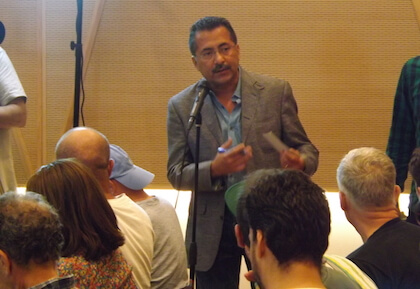Records obtained by a leading advocate for accountability and transparency among gay and AIDS groups show that the National Association of People With AIDS (NAPWA) was struggling to stay afloat for nearly four years before its 2013 bankruptcy.
And in a memo filed in NAPWA’s bankruptcy earlier this year, Tyler TerMeer, the association’s former board chair, accused Frank Oldham, NAPWA’s former president and chief executive officer, of stealing at least $62,000 from the AIDS group.
As early as April of 2009, the board’s executive committee instructed NAPWA’s “senior staff” to find cuts worth $300,000 in the agency’s budget for that year, according to records obtained from the federal Centers for Disease Control and Prevention (CDC) by blogger Michael Petrelis.
National Association of People With AIDS board filing claims $62,000 in “theft” by Frank Oldham
In 2006, NAPWA had just over $1.9 million in revenues, according to a Form 990 it filed with the IRS. Revenues fell to a low of $1.25 million in 2009 then climbed to $1.4 million in 2010. Gay City News could not find Forms 990 for 2011 and 2012.
NAPWA was overly reliant on government contracts, with cash from those sources accounting for half of its revenues in 2008 and 43 percent of its revenues in 2007. Federal dollars accounted for just over 40 percent of NAPWA’s revenues in 2009 and 2010, but as federal support fell, the agency was not replacing those funds with private or foundation money. It was ending successive fiscal years in debt and borrowing from a $250,000 credit line it had with Bank of America. By September of 2010, NAPWA had borrowed just over $199,000 on that credit line. It was paying 7.5 percent interest on that debt.
By 2010, NAPWA was losing staff and cutting wages as part of a “sustainability plan” it implemented in 2009 and 2010. A memo, which was written by TerMeer and filed in NAPWA’s bankruptcy proceeding earlier this year, notes that wages were reduced for all staff in 2010, 2011, and 2012 “to meet current operating costs and avoid any further reduction in the NAPWA workforce.” In 2011, “payroll had been suspended for all employees for lack of funds” in one pay period, TerMeer wrote. This was after NAPWA was “operating with a minimum number of staff to maintain basic operations and services,” according to a 2010 document in the CDC records.
Gay City News reviewed the bankruptcy filings after receiving the CDC documents from Petrelis.
In 2009, NAPWA already did not have enough people to fulfill a contract it had with the CDC, as evidenced by reports filed with that agency noting that certain benchmarks were not completed due to a lack of staffing. Complaints about staff losses harming agency operations continued into 2011 in NAPWA reports filed with the CDC.
The “sustainability plan” was also supposed to find new revenues, but that part of the plan never happened. It appears that NAPWA was funding some operations by not paying other obligations, such as payroll taxes and other taxes. The IRS, Maryland, Montgomery County in Maryland, and New York State all filed liens in the bankruptcy case.
NAPWA was also the fiscal sponsor for the Treatment Access Expansion Project (TAEP) at Harvard University. The TerMeer memo charges that Oldham transferred $100,000 that belonged to TAEP to a NAPWA account. “It is possible that NAPWA eventually returned approximately $65,000 of those funds transferred from TAEP,” but that cannot be confirmed, TerMeer wrote. Another document that was filed in the bankruptcy this past October 3 indicates that TAEP is owed $100,000. Robert Greenwald, TAEP’s director, did not respond to an email asking if the program got its cash back.
In early 2013, NAPWA announced it was filing for bankruptcy with $750,000 in debts and less than $50,000 in assets.
The TerMeer memo says that following Oldham’s announcement in late 2012 that he would resign from NAPWA at the end of the year, the board first placed him on administrative leave then told him “that his employment would be terminated unless he presented evidence to rebut evidence that he had committed alleged acts of fraud, misdealing, malfeasance, theft or defalcation in breach of his employment agreement.”
The memo alleges that Oldham used a NAPWA credit card to pay for “alcohol, groceries, utilities, local travel and meal expenses, other personal expenses” and that he drew cashier’s checks totaling $11,850 on a NAPWA account that were payable to “Mr. Oldham, his attorney, his landlord and another party.”
Altogether, TerMeer asserted that Oldham appeared to have spent $62,641.95 of NAPWA cash on unauthorized expenses. The bankruptcy filing has Oldham owing NAPWA just over $88,000, and Oldham filed claims in the bankruptcy asserting that NAPWA owed him over $111,000 in back pay, vacation time, and other expenses.
Oldham did not respond to a call seeking comment, and TerMeer declined to comment for this story.
NAPWA referred the case to the Montgomery County prosecutor, who told Gay City News that an investigation into the complaint was ongoing.
“Financial cases can sometimes take a long time,” said Ramon Korionoff, a spokesman for Montgomery County in Maryland. “Currently, it is still under investigation.”



































